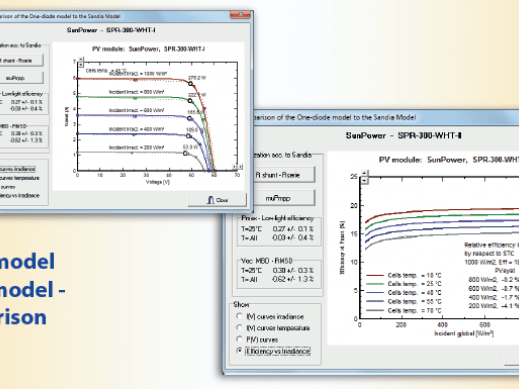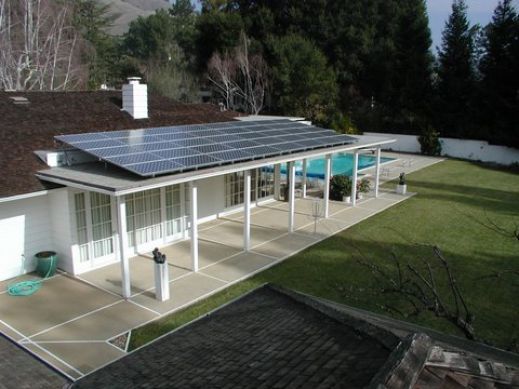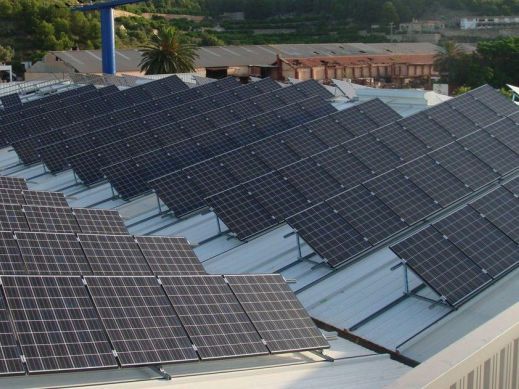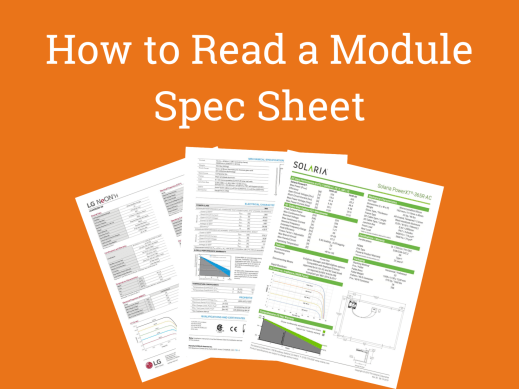
A solar project smaller than 2.5 kW takes only a few days to design and install. The freedom and sense of accomplishment that such a project grants the home owner lasts for years. Photovoltaic systems give individuals the ability to become self-sustaining and to control the cost of their electricity - PV systems also teach a fundamental lesson of local production and consumption unlike any other experience. The California Energy Commission published "A Guide to Solar PV Design and Installation (pdf)" to enable more citizens to go solar on their own .
Don't be intimidated, it's easy if you are fully prepared!
To begin, We'd like to mention that you can consult with Greentech Renewables to assist with all of your system design needs by filling out the online PV Design Request form on our website.
We will list the basic steps for do-it-yourself solar enthusiasts. You don't have to be an engineer, nor do you have to actually purchase equipment at this stage. Just as a starting point, follow these 10 easy steps:
1) Know how much electricity (kWh) you consume and know your electricity rate
To understand the economics of installing a solar system it is important that you determine how much electricity you consume in a year. A summary of your electricity usage is on your utility bill, make sure you do not include natural gas usage in your calculations. Please note that a solar PV system would offset your electricity demands mostly in the summer months (Not because of the temperature, rather because the path of the sun varies with the seasons, it is optimal for PV systems during the summer). Also, note that most utility companies have a tier rate structure based on consumption patterns and state mandates. A small PV system could reduce your electricity needs enough to move you to a different tier, lowering your rates and saving you a large amount of money.
2) Know how much available roof space (sq-ft) you have
To determine how many solar panels you can actually use, it is important that you know how much roof space you have. Based on the size of your house, draw a diagram of your roof on a piece of paper. If you'd like to be more technical, you can use the free tool Google SketchUp or a free CAD program DraftSight. Once you have determined the size of your roof it is important to know how much of your roof faces towards the equator (South in the northern hemisphere [USA, Canada, etc.], north in the southern hemisphere [Australia, South America etc.]). Solar irradiance is strongest coming from the equator and you will want to maximize the efficiency of your system.
3) Know your solar radiation data and calculate how much energy you could generate
You can consult the NREL website (National Renewable Energy Lab) for official government statistics on your area. You can also use PV Watts’ or Solmetric's solar calculators.
4) Know your shading issues
If there are obstacles like trees or buildings in the vicinity of your roof that might create shade, you need to be careful. Shading can reduce the output of your system and may also damage the solar cells. You can use Solar Pathfinder or Solmetric Sun Eye for detailed shading analysis. Some utilities rent or loan these devices.
5) Select an appropriate solar module
There are hundreds of different solar panels on the market, determining which is the perfect fit for you can be complicated. The size (surface area) of the module and the solar rating are the most important factors. Please note, although the solar ratings might be the same for some modules, the voltage and current output might vary (It is advised to select a lower voltage module for smaller projects [less than 4 kW]). Other differences, such as color and financial limitations may also be a factor.
6) Select an inverter
Similar to choosing a solar panel, selecting an inverter out of the many available is not easy. Consider using micro inverters that are easy to install and that generate AC power directly from the module. If you want to use a central inverter please read the linked article and use the string sizing tools.
7) Choose a racking system to mount your solar PV system on your roof
Remember that 10% to 25% of the total costs will be the racking system. Pay attention and take your time to decide which racking system is most suitable for your budget and for your roof. The racking system is going to last for at least 20 years and it's one of the key components since it protects both the roof and the modules. A small mistake with the racking can permanently damage the roof or injure people or property.
There are a number of different racking and mounting systems available in the market for roof mounted solar systems. Check the manufacturer's websites, read the installation manual. Be aware of the codes and plan how you are going to mount the racking system on the roof. Learn about flashing solutions; I mentioned some options in the linked article.
Using an inexpensive racking solution does not mean lower quality, it might require more effort to install it or the materials may be different. To have a glimpse on how to design a roof mount system, you can either refer to a previous article or you can use Unirac's roof mount part estimator.
Additionally, as the solar PV field matures unique racking solutions, such as hanging panels vertically along an exterior wall, become more applicable.
8) Learn your local and state incentives, calculate how much money ($) you could save
Check the DSIRE (Database of State Incentives) website. There are also a number of other financial calculators available online. Most importantly, you need to estimate your electricity generation and compare it to your utility rate. Note that different tier rates might apply depending on your energy consumption.
Call you utility company and learn about their solar programs. Learn the applications process. Make use of incentives and tax cuts.
9) Get your documents ready
Every city has a different permitting process. In order to apply for an incentive or to receive a construction permit, you will need to obtain the equipments' (module, inverter, racking) data sheets, and submit a roof drawing and electrical drawing. You can draw those on your own using the programs mentioned above, or ask a professional to draw them for you.
The electrical diagram requires some electrical knowledge in order to determine the wire sizes, voltage drops, AC and DC disconnects. Contact an electrician if you don't feel confident about it.
10) Go Solar!
Once you feel confident with your system, you can consult a sales person or distributor. If you want to install the system on your own, read some books about it first. Or just contact a local electrician and install it together.
It will take 5 to 15 hours of work to install a small solar system on your roof, which could be done in one or two days. Then you can watch your meter run backwards and enjoy clean energy.




Comments
You also might want to read these articles. I found them to be really helpful as I designed and installed my own system.
Federal Solar Energy Incentive FAQ.
How do you size a home solar system?
I read that in Southern California in the SCE region to complete the CSI claim form you need to peform a shading analysis with your application. As a self installer can you use the SunEye or the Pathfinder to complete this report?
Yes you can, both the SunEye and Pathfinder generates a complete shading analysis report for you.
If you own the home where the solar will be installed, can you submit your ownd design and still receive California Solar Initiative funding or does a licensed contractor need to submit the paperwork to receive CSI funds?
In most cases the installer is going to handle the paperwork. In order to be eligible for self-installation, you'll need to attend a one-day seminar at PG&E, and then you can do all your work for your home.
You can find the related documentation on this link; PG&E, CSI Program
Great article, for more info, check out Solar PV System Design.